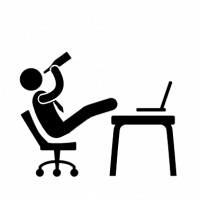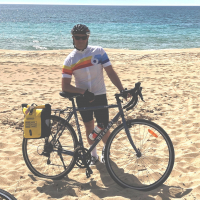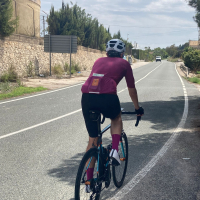Removing stuck pedals
Comments
-
#threadgate.
Sorry s_j_pwmb. After this post I also googled thread pitch.
You are correct and I am wrong.
Anything after a certain point was just for fun and immature. This pic I sent was for a thread cutter:-
Hope you take this in the manner I meant it to be and only having fun, sorry again if I offended you s_j_pwmb.
1 -
Wow! someone on t'internet just admitted to being wrong.
Have a load of clapping hands emojis.The above may be fact, or fiction, I may be serious, I may be jesting.
I am not sure. You have no chance.Veronese68 wrote:PB is the most sensible person on here.1 -
.
0 -
I was beginning to wonder whether this was a wind-up! 🤣
Hope you take this in the manner I meant it to be and only having fun, sorry again if I offended you s_j_pwmb.
No offence at all, and it is much appreciated that you ‘fessed-up and didn’t just disappear. Thanks for the sparring match.1 -
I was beginning to wonder whether this was a wind-up! 🤣s_j_pwmb said:
Hope you take this in the manner I meant it to be and only having fun, sorry again if I offended you s_j_pwmb.
No offence at all, and it is much appreciated that you ‘fessed-up and didn’t just disappear. Thanks for the sparring match.
Touche Pal! 😎👍👍0 -
This has got to be one of the most confusing threads I’ve read and I know what I’m doing, or at least I thought I did
Righty, tighty, lefty, loosey – I’ve never heard that before, thank goodness.
The fact is a spanner (and nut or bolt) goes both left and right also up and down, given the bolt axis is on the horizontal, it’s a circular motion. Therefore the only expressions that make any sense are clockwise or anticlockwise.
Like people, most threads are right-handed, that’s the standard. Rule: Clockwise = tighten, Anticlockwise = untighten. Unless there is an application where the motion would/could cause the standard right-hand thread to unscrew, then a left-handed thread is used and the rule is reversed. As in the case of the left pedal on a bicycle
I wasn’t going to say anything, but hey ho…0 -
To be pedantic, a better way of expressing it is that on a standard thread clockwise will move the item away from you, and anticlockwise will move it towards you. (use the right-hand-rule where your thumb is the direction of travel and your fingers point in the rotational direction). When you’re looking at the right pedal from the crank side (I.e. when you’re putting a hex-key in it) then you’ll turn the hex-key clockwise to unscrew the pedal, which is counterintuitive, but correct.Charlie_Croker said:This has got to be one of the most confusing threads I’ve read and I know what I’m doing, or at least I thought I did
Righty, tighty, lefty, loosey – I’ve never heard that before, thank goodness.
The fact is a spanner (and nut or bolt) goes both left and right also up and down, given the bolt axis is on the horizontal, it’s a circular motion. Therefore the only expressions that make any sense are clockwise or anticlockwise.
Like people, most threads are right-handed, that’s the standard. Rule: Clockwise = tighten, Anticlockwise = untighten. Unless there is an application where the motion would/could cause the standard right-hand thread to unscrew, then a left-handed thread is used and the rule is reversed. As in the case of the left pedal on a bicycle
I wasn’t going to say anything, but hey ho…
I therefore stand by the comment ages ago, ignore the acronyms, rules, and names and just stick the hex-key/spanner on pointing forwards and pull-up!
Don’t get me started on spoke nipples which aren’t merely counterintuitive, but they also do opposite things depending on which side the spoke is connected to the hub 🤯0 -
I also apologise to anyone who reads this thread, will read in the future, other participants and the OP.me-109 said:Righty-tighty is correct for a right-hand thread.
For clarity everything I posted before this point was not part of any wind up and truly believed the previous posts I made to be factual and true including, 'righty, tighty, lefty, loosey', a common phrase I heard a lot over the years!!!! 🤯1 -
Maybe the fairy-mods could delete the thread and just post a new redacted 'question | answer' version?

To be fair, a decent FAQ would cut down on a lot of board traffic.0 -
Just watch a park tools video? But pedals TIGHTEN in the direction you normally ride ie forward since this keeps the pedals tight. You never need to overtighten pedals.0
-
But if you under tighten them the pedal works loose and strips the thread.amrushton said:Just watch a park tools video? But pedals TIGHTEN in the direction you normally ride ie forward since this keeps the pedals tight. You never need to overtighten pedals.
#bitterexperienceThe above may be fact, or fiction, I may be serious, I may be jesting.
I am not sure. You have no chance.Veronese68 wrote:PB is the most sensible person on here.0 -
You've just proved s_j_pwmb's point and depth charged your own arguments. The thread labelled RH in your pics would have to be rotated to the right to tighten it due to the pitch of the threads. Conversely the pic labelled LH would have to be rotated left to tighten itreaperactual said:
EDIT - apologies to reaperactual - came in part way through the thread and missed his later retraction. Anyway it was an amusing verbal fencing match - hopefully the OP has got the message in the end1 -
He's already admitted the error of his ways.
Why bother reading a thread when there is a chance to put someone down. The above may be fact, or fiction, I may be serious, I may be jesting.
The above may be fact, or fiction, I may be serious, I may be jesting.
I am not sure. You have no chance.Veronese68 wrote:PB is the most sensible person on here.1 -
No apologies necessary! I deserve a ribbing and welcome it. Every day is a school day. 😎👍0
-
Got the pedal off with a pedal spanner eventually.
Used plenty grease on new pedals and just nipped them up to tension to hopefully avoid a repeat in future!1 -
👍 All’s well that ends well 😊2
-
You do realise those pictures are the wrong way round don’t you?reaperactual said:

PP
Ah, I now see on page 2 others have pointed this out already. As you were, confused to hell, nothing to see here, move along now.
0 -
-
Hi.
Not sure if this is exactly what you need but when my pedal was completely stuck and nothing would even begin to budge it. I took off the crank and packed it with ice for a good half hour. That made all the difference and then using a long wrench and starting with some careful hammer taps I was able to get the pedal off without too much trouble.
Hope that helps.0 -
This! I learned this years ago - they always tighten in the direction of the wheels going forward - it is not difficult to then deduce how they loosenamrushton said:Just watch a park tools video? But pedals TIGHTEN in the direction you normally ride ie forward since this keeps the pedals tight. You never need to overtighten pedals.
Wilier Izoard XP1 -
Not sure that someone pointing out the bleeding obvious is worthy of a flag. 🤔The above may be fact, or fiction, I may be serious, I may be jesting.
I am not sure. You have no chance.Veronese68 wrote:PB is the most sensible person on here.0 -
Me neither but what the hey, I've stuck a flag in it too. 🚩😃pblakeney said:Not sure that someone pointing out the bleeding obvious is worthy of a flag. 🤔
0 -
I thought on the Internet you can do what you like with the laws of maths and physics 😁s_j_pwmb said:reaperactual said:Righty tighty is correct for left hand, standard, everyday screws nuts and bolts.
Right hand thread is for bb's (except Italian threaded) and left pedals and crank arms.
NO IT IS NOT!!!!
Normal everyday threads are RIGHT HANDED (hence righty-tightly) following the right-hand-rule which is to do with mathematical vectors and rotational moments. If standard righty-tightly were true for left hand threads then our laws of maths and physics would be wrong!
Unusually some threads are left-handed for particular applications (including gas fittings, industrial water valves, and applications where rotational forces dictate that a standard right hand thread will unscrew) and these are generally marked with two notches on the nut crest.0 -
Being a bit of a simpleton I can never remember which one goes which way so I check another one that isn't fitted. If I ever have to remove a pedal without having a spare one to look at I will struggle.0
-
Right pedal (cranks) - Right Hand (normal) thread. Right (clockwise) to tight.
Left pedal - Left Hand (opposite to normal) thread. Left (anti-clockwise) to tight.The above may be fact, or fiction, I may be serious, I may be jesting.
I am not sure. You have no chance.Veronese68 wrote:PB is the most sensible person on here.0 -
I've mentioned this before on here, but perhaps worth repeating this technique as it removes the need to remember which way the threads are and there's also no risk of skinning knuckles on the chainset...
Point crank forward towards front of bike, parallel with the ground.
Apply Allen key or pedal spanner so that it points the same way, effectively continuing the line of the crank.
Hold end of Allen key/spanner in your hand. Push down on pedal/end of crank with your foot.0 -
So if RHS pedal has standard thread and LHS pedal has reversed thread, this is to tighten them then?mrb123 said:I've mentioned this before on here, but perhaps worth repeating this technique as it removes the need to remember which way the threads are and there's also no risk of skinning knuckles on the chainset...
Point crank forward towards front of bike, parallel with the ground.
Apply Allen key or pedal spanner so that it points the same way, effectively continuing the line of the crank.
Hold end of Allen key/spanner in your hand. Push down on pedal/end of crank with your foot.
As per pic?
Sometimes. Maybe. Possibly.
0 -
The technique I describe above is for removing the pedals.photonic69 said:
So if RHS pedal has standard thread and LHS pedal has reversed thread, this is to tighten them then?mrb123 said:I've mentioned this before on here, but perhaps worth repeating this technique as it removes the need to remember which way the threads are and there's also no risk of skinning knuckles on the chainset...
Point crank forward towards front of bike, parallel with the ground.
Apply Allen key or pedal spanner so that it points the same way, effectively continuing the line of the crank.
Hold end of Allen key/spanner in your hand. Push down on pedal/end of crank with your foot.
As per pic?
For fitting pedals, all you need to remember is to screw them in in the direction the wheels would spin when riding, i.e. rotate forwards.0 -
A couple of sets of my Shimano pedals ( 105 and Ultegra ) have a helpful little arrow printed on them, showing which way to turn the collars to loosen them, just in case it gets confusing.0








